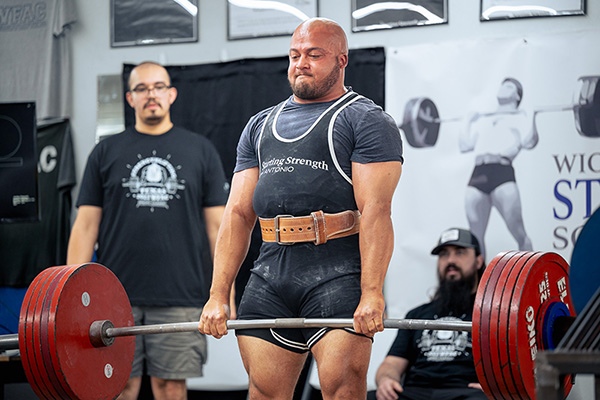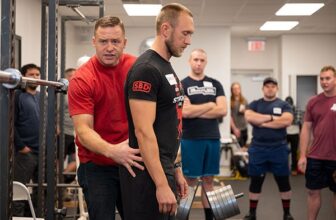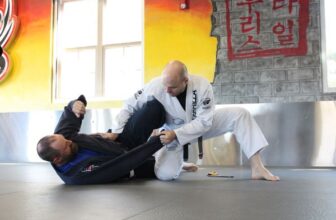
[adinserter block=”2″]
When I started lifting weights back in
1977, our only references were the bodybuilding magazines. There were
a few books, but we didn’t know that. Occasionally ABC’s Wide World
of Sports would show some Olympic lifting, or even powerlifting on
rare occasions – Paul Jordan’s famous wreck under the squat at the
1977 Worlds in Australia was part of their intro video montage for at
least 20 years. Iron Man magazine, headquartered in Nebraska,
was pretty good in that the Raders would print just about anything
related to training, but it was sometimes hard to find. On a regular
basis, Hoffman’s East Coast magazines Strength and Health and
Muscular Development, and their rivals on the West Coast, the
Weider magazines were about all there were.
I remember reading two guys in Iron
Man – Bradley J. Steiner and Stuart McRobert – that made a
lot of sense, and shaped my later thinking on training. But unless
they ran a piece on powerlifting (or Olympic lifting in S&H), the
East and West Coast magazines were almost exclusively based on the
idea that the human body was composed of parts: your chest
(pecs and delts), your back (your lats), your legs (quads,
hamstrings, and calves), and your arms (“bis” and “tris”).
And your abz. Can’t forget those.
This thinking has thoroughly permeated
the entire fitness industry, to the extent that large commercial gyms
have two basic areas on the exercise floor: the treadmill area and
the arms area. If it’s not cardio, it’s bodypart machines, and a
productive workout must include a minimum number of muscle groups as
well as time on the treadmill – “shredding your abz, my man.”
I’ll bet you that 80% of the guys
hanging around in the big commercial gyms are doing “Arm Day”
today, “Chest Day” tomorrow, “Back Day” pretty soon, and “Leg
Day” is under consideration – but hey! I run already, and running
is Legs. Abz are of course done “Every Day.” Bodypart training is
the direct result of seeing pictures of Arnold, Franco, Lee Haney,
Tom Platz, Mike Mentzer, Dorian, Ronnie, and all the other famous
bodybuilders in the magazines, and failing to appreciate how strong
they actually were and how they got that way. When you see still
pictures of these fantastically muscular men, you are looking at
their bodyparts, because they are showing you their bodyparts, and
you therefore train bodyparts.
You see the results of bodypart
training on genetically-gifted people, whose congenital attributes
include “normal” anthropometric proportions, thin skin, low sub-Q
bodyfat, long fat muscle bellies, and the ability to discipline their
training and diet. The vast majority of the human race cannot look
like these guys, and a normal psychological profile precludes it
anyway. But that didn’t keep you from wanting to look like them. They
were big strong-looking men. Weider was very good at his job:
bodypart training is about appearance, and Joe knew who to show you
pictures of.
Bodypart training is analogous to
cosmetic makeup: to make yourself more beautiful you change the
appearance of small features on your face, while ignoring the fact
that the rest of you still looks like shit. You think that visible
abs make you look better, so you do lots of crunches, but we can’t
see them through your shirt.
What you don’t see are movement
patterns, what humans actually do with their muscles and bones
and tendons and nerves, and what mortals such as ourselves have to
worry about. Bodybuilders pose – you and I live and work.
Our daily existence consists of physical interaction with the
material world around us, and that interaction is through the
application of force. Not the intellectual, the spiritual, or the
aesthetic, but through force applied by our bodies to our
surroundings. Walking, running, picking up the kids, driving the car,
working in the yard, moving the furniture, digging a hole –
everything you do that is outside the realm of abstract ideas is
physical, and those things depend on your ability to produce force.
The majority of the human race needs to
improve strength – the ability to produce force against an
external resistance, because we use our strength, not our
aesthetics. Old people lose their ability to physically function as
effectively as younger people because they are not as strong, and
their lack of razor abz has nothing to do with it. Strength degrades
with age, and although we can do something about this most of us
won’t.
A picture of a big bodybuilder’s arms
communicates to you the idea that your arms can and must be
made to look like that. Ditto pecs, quads, delts, and of course abz.
But the way the bodybuilder’s arms got big is not the way you or
anybody else actually uses their arms. Strength is improved through
an increase in force production capacity within the movement patterns
normal to our musculoskeletal anatomy. Squatting down and standing
back up, picking things up, pushing things away and up, pulling
things down and in, and throwing things are the movement patterns
natural to humans and their arms – dumbbell preacher curls
are not.
If your training is therefore focused
on normal human movement patterns that are incrementally loaded with
progressively heavier weights, you will get stronger. This takes a
very few carefully-selected exercises, performed correctly over the
longest effective range of motion, that are incrementally increased
in load. None of these exercises use one muscle group at a time, all
of them involve several joints at a time, and all of them are capable
of using more weight than more isolated versions of the movement
pattern.
There is a stark difference in these
two approaches to training. Bodypart training involves devices
designed to allow the use of small groups of muscles at one time,
using weights that are only sufficient for small groups of muscles.
Dumbbells allow you to work one arm at a time, or one shoulder at a
time, and this does not produce a long-term training effect. You can
even work one leg at a time with “Bulgarian split squats” –
invented by the Bulgarians to help them defeat the USSR – or with a
knee extension machine, apparently invented by Jack LaLanne to work
his quads and improved upon by Arthur Jones to make lots of money.
But unilateral exercise does not produce a long-term training effect,
because it cannot expose the whole body to sufficient stress to
produce a systemic adaptation.
It does, however, allow you to watch
the muscle group being exercised, and enjoy the immense satisfaction
of self-appreciation, as your rippling biceps stun. Mirrors
are an important tool for bodypart training.
In contrast, strength training is
designed to increase the ability of the whole body to produce force,
and this is accomplished by using as much of the body at one time as
possible. Strength training is “bilateral” (both sides at the
same time), because that’s the way the body works when it produces
maximum force, and it’s therefore the most efficient way to make it
stronger. Strength training uses barbells, the best way to load a
normal bilateral human movement pattern. In strength training, the
load is the primary concern, since increased force production
is the goal. Dumbbell curls may make your arms look better –
standing presses make both you and your arms stronger.
If you load a barbell on the floor with
the most weight you can pick up for 5 reps, we know how strong you
are today. If you come back 2 days later and go up 5 more pounds, you
have started a process that can take you from 135 pounds to 405
pounds. Same for the squat, the press, the bench press, and a couple
of other similar movement patterns. This is strength training – the
intentionally progressive loading of normal human movement patterns
for the express purpose of increasing the force production capacity
of the whole body.
And here’s the damnedest thing about
this: if a 155-pound guy goes through this process for 6-8 months and
gains 35 pounds of bodyweight while getting his squat up to 335, his
press to 135, his bench to 250, and his deadlift to 405, he looks
better than the same guy doing dumbbell curls and unilateral legs
with light weights. Because he’s stronger – he looks
stronger, and he carries himself like a stronger man, and this is
quite noticeable. He was not trying to look better; he was trying to
get stronger, and now he looks better accidentally because the
human eye recognizes physical strength as an admirable
characteristic. Joe Weider was right, accidentally.
This is true in every culture and every
society in the world, and it is buried in our DNA to the extent that
physical strength is recognized by all other humans. Strength is
recognizable in your appearance, in your gait (frail people walk
differently than strong people), in your voice, in your opinions, in
your decisions, and in your actions. Strong is useful, and useful is
good. Barbell strength training makes you stronger, and bodypart
training is merely fucking around in the gym, wasting time that could
be spent getting stronger. Think about this before you run out of
time to waste.
Discuss in Forums
[adinserter block=”2″]
Credit : Source Post







